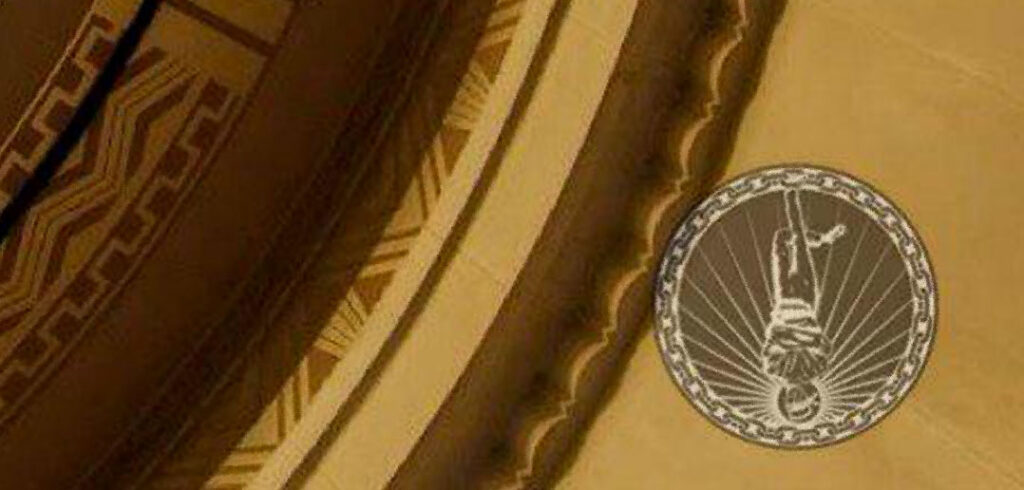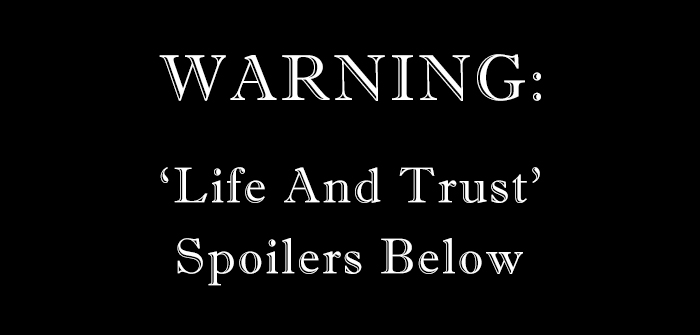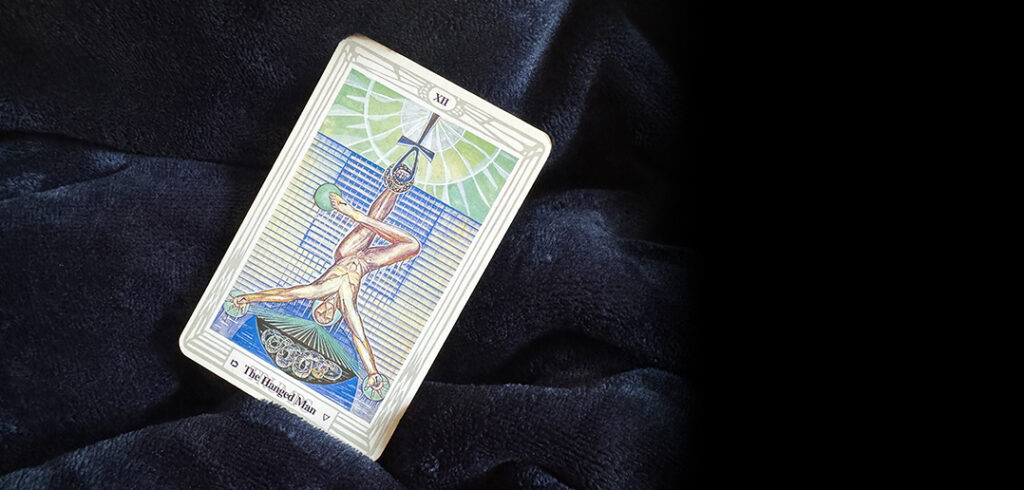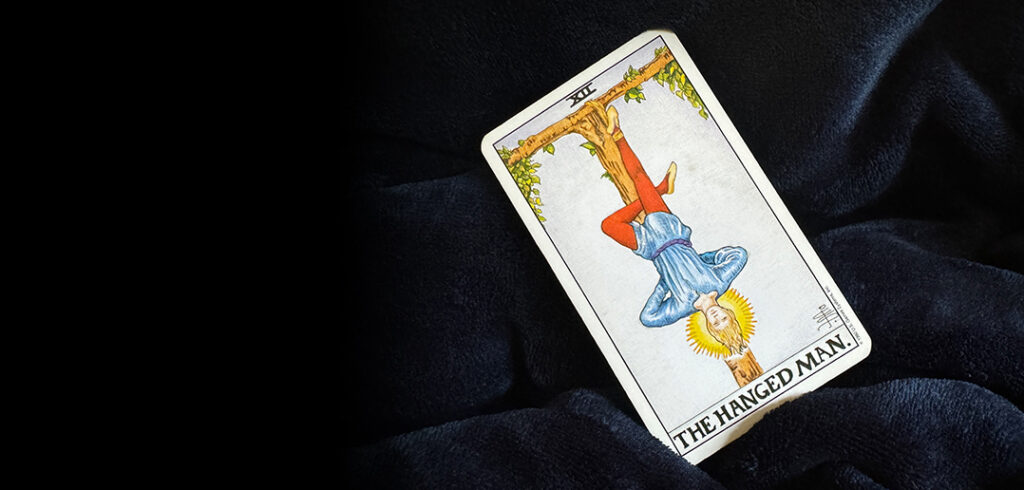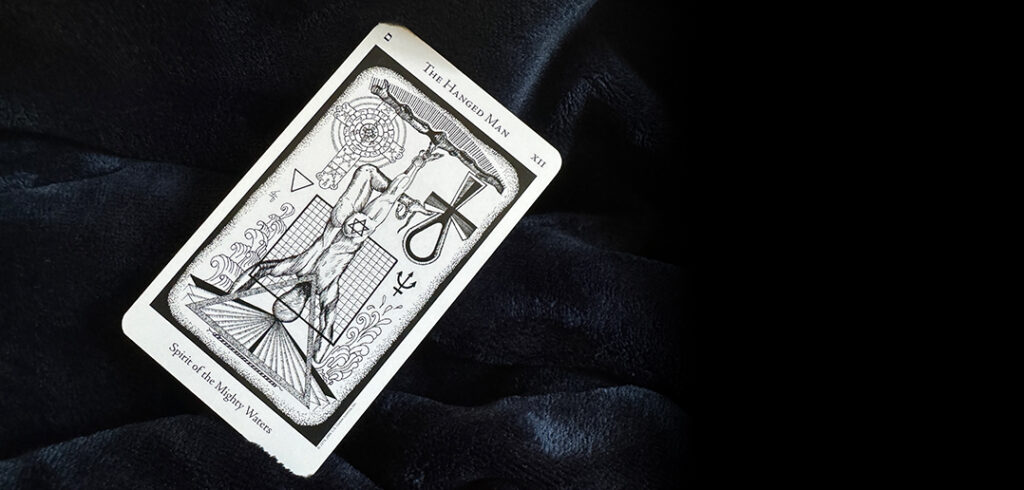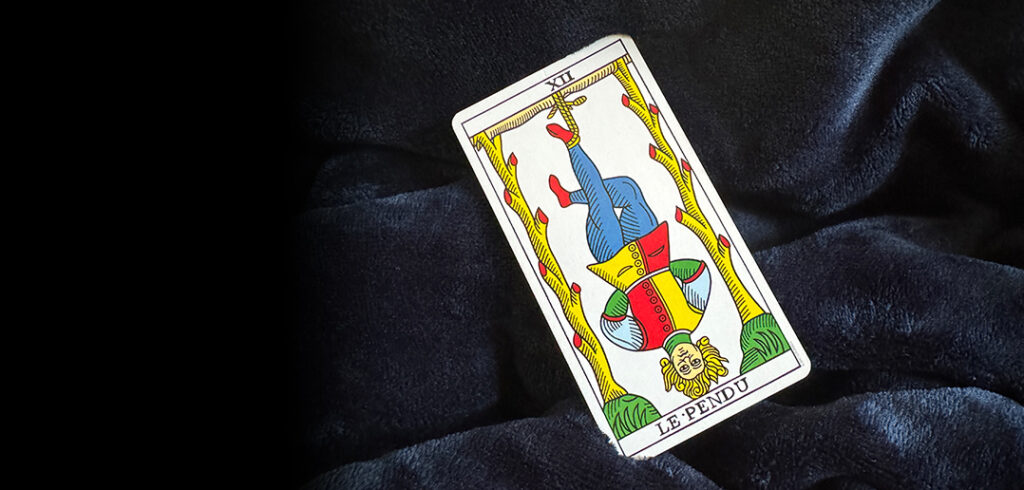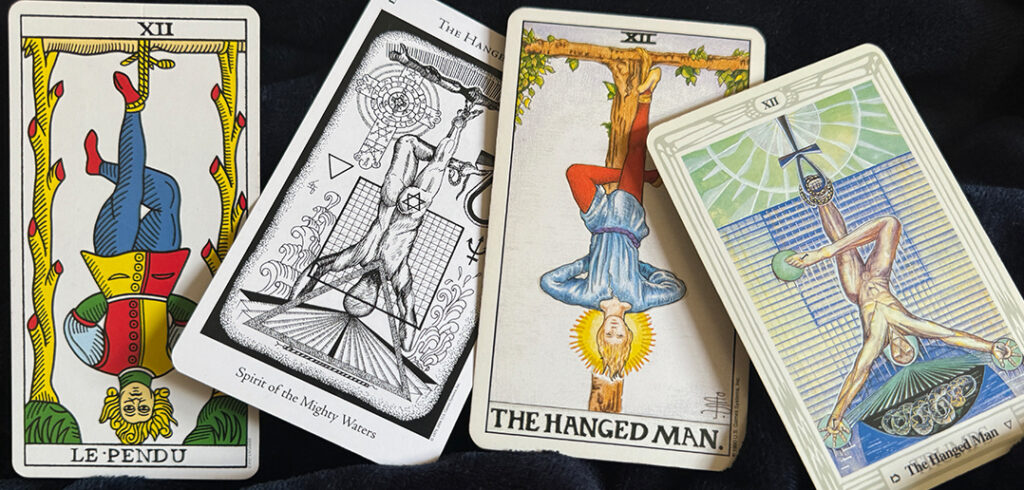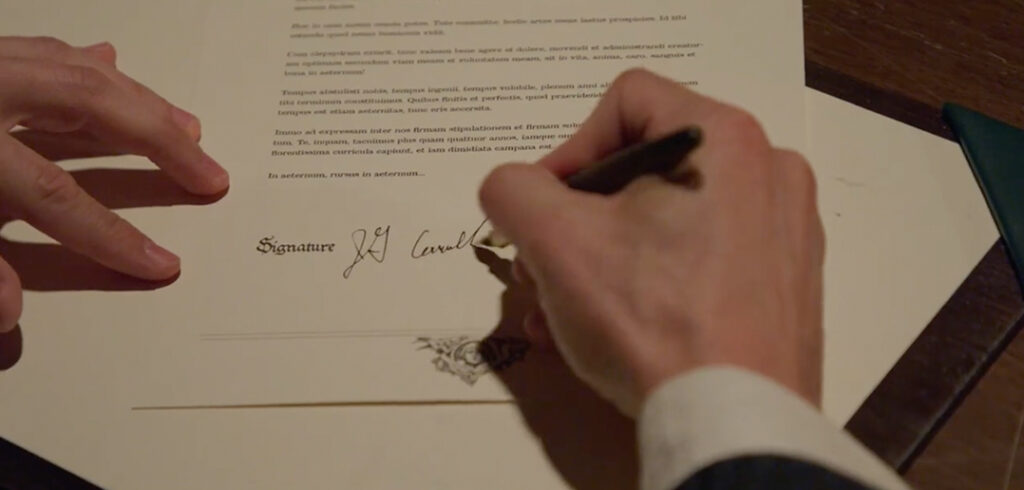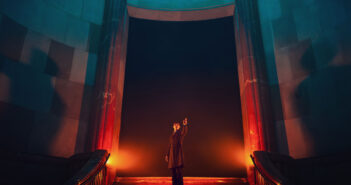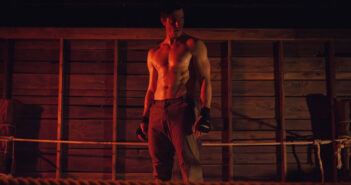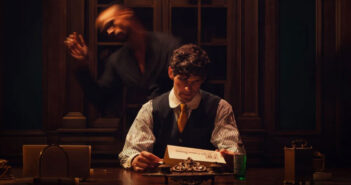Emursive submitted a creative-overview specimen to the United States Patent & Trademark Office on 09 February 2024 for the now-live show, Life And Trust.
The overview showcased an Egyptian-styled backdrop with the Life And Trust logo in full view (the F, A, U, S, and T letters were slightly faded). Along the bottom were five seal-like logos. These emblems contained standard-issue occult imagery: the all-seeing eye, an eagle, the pyramid, the Caduceus, the Tree of Life, you get the idea.
But it’s the fifth one that was especially peculiar and spooky.
It was a man hung upside down by the right ankle. His left leg was bent at the knee and crossed behind the right. He was confined in a straightjacket. Beams radiated from his head. A chain wrapped around the circular border of the seal.
It was the Hanged Man of the Tarot—confined.
Occult Influences
Occult mysteries and secrets societies showing up in Life And Trust NYC were speculated about early on.
The speculation shot up when Jon Ronson revealed himself as the writer of the immersive show’s narrative. He’s no stranger to weird occult stuff in his books and documentaries.
There’s no better secret society to lend inspiration to Ronson and Emursive than the Hermetic Order of the Golden Dawn. The prologue of Life And Trust NYC starts out in 1929, but afterward we’re transported back to 1894.
Perfect timing, because the Golden Dawn existed from 1887 to 1903. I have no doubt it is the Golden Dawn that inspired Life And Trust’s Alexandria Club; both organizations use the mysterious style and pageantry of ancient Egypt.
The most influential Tarot deck of modern time came from an occult historian who actively participated in the Hermetic Order of the Golden Dawn—A.E. Waite. The deck in question is the Rider-Waite. Waite wrote the instructions and descriptions for the deck. Pamela Coleman Smith (also a member of the Golden Dawn) fully illustrated all of the 78 cards. The Rider Company originally published the pack in 1909. (The Rider-Waite Tarot deck is used in Life And Trust NYC.)
Then there’s Aleister Crowley’s Book of Thoth. This deck was illustrated by Lady Frieda Harris; all of her images originated from psychedelic watercolor paintings. They’re truly a marvel to admire. The Thoth deck, as the name implies, is heavily influenced by the mysteries of ancient Egypt. The Priestess is Isis, the Hermit is a red-robed Thoth, the Moon is guarded by Anubis, and so on.
Crowley and Harris’s presentation of the Hanged Man is especially unearthly. It might be the most striking image in the entire deck, and that’s saying something.
It’s an alien figure whose left ankle is suspended from an Egyptian ankh. It hangs over a geometric field of aquatic blues and greens. Its arms are outstretched before him, its palms crucified.
And I’m not kidding when I say it’s alien.
Not only does the character remind me of the entity Crowley supposedly summoned in New York in 1918—LAM. But it also looks eerily similar to the sacrificial Engineer at the beginning of Ridley Scott’s Prometheus.
Talk about fitting.
Similarities And Differences
The Hanged Man (card 12) comes after Justice (card 11) and before Death (card 13).
Because the card comes before Death, the character of the Hanged Man is one of willing sacrifice, of letting go, of accepting death in order to enter into a new beginning.
In the Rider-Waite Tarot deck, the Hanged Man is suspended upside down by his right ankle from a wooden gallows. His left leg is bent at the knee and crosses behind the other. His arms are bound behind his back. He wears a blue tunic and red leggings. His hanging blond hair is crowned by a golden halo.
The Hanged Man (“Le Pendu”) of the French Marseilles deck is a motley character largely resembling what A.E. Waite and Pamela Coleman Smith came up with, minus some of the flourishes.
The Hanged Man of the Golden Dawn’s Tarot deck is the only one I’ve seen where the figure is facing away from view, showing us his back side. His head is eerily blank and oval, Slender Man-style. The Golden Dawn bestowed special titles upon each figure appearing in its version of the Tarot, and for the Hanged Man it is the “Spirit of the Mighty Waters.”
The Golden Dawn version of the Hanged Man somewhat resembles the Thoth version Crowley came up with, which I’ve already gushed over. It makes sense since Crowley was a member of the Hermetic Order of the Golden Dawn, too. The influences are obvious.
There are some minor differences in the fundamental presentations of these four iterations that are worth noting.
First, the suspended ankle.
The Hanged Man of the Rider-Waite deck hangs from his right ankle. But in the other three decks I’m referencing from my personal collection (Marseilles, Thoth, and the Golden Dawn), he’s hanging from his left ankle. In the Rider-Waite and Marseilles decks, the opposite leg is crossed behind the suspended limb. In the Thoth and Golden Dawn decks, it’s crossed in front.
I have no idea what the differences mean, but they’re interesting points to note.
No Definitive Origin
Author and occult historian Colin Wilson spent several paragraphs analyzing the Hanged Man in his 1971 book, The Occult: A History. He pointed out a handful of oddities.
It’s typically assumed this card represents gods and spirits of sacrifice like Osiris, Odin, Prometheus, Jesus, Dionysus, Orpheus, and so on (I sign on to this belief). But because the Tarot has no definitive origin, it’s impossible to really know the true root of inspiration.
As Wilson noted, none of the figures mentioned above died by hanging the way the Hanged Man is presented, if hung at all.
Yet each manifestation of the card as it appears throughout history (as early as 1329, based on Wilson’s research) stays true to the core details. This was during a time before printing presses, let alone any kind of mass communication across countries like Germany, Italy, France, and possibly Egypt.
So how could all of the renditions get these odd details right?
As Colin Wilson summaries in The Occult:
One of the oddest things about the Tarot pack is that there seem to be no legends concerning its origin, although an eighteenth century philologist, Count de Gebelin, declared that it is fundamentally an ancient Egyptian work called the Book of Thoth.
But this was before the Rosetta Stone enabled scholars to read Egyptian hieroglyphics; and it must be admitted that subsequent investigations unearthed no sign of the Tarot pack in ancient Egypt…
Wilson is ultimately never sold on the idea that the Hanged Man is just a representation of sacrificial gods. He believes there’s something more to the specific details.
He’s just not sure what.
Beautiful And At Peace
Author and Tarot historian Rachel Pollack jumped right into the speculation over the Hanged Man at the beginning of her 1980 book, Seventy-Eight Degrees of Wisdom.
Just like Colin Wilson, she couldn’t quite figure out the specifics.
Pollack wondered if the card is a nod to the upside-down crucifixion of St. Peter. Maybe it acknowledges North American and Siberian shamans suspending themselves upside down to induce specific states of consciousness (though how various artists would know this in the Twelfth Century is a mystery). There’s even a documented practice among male alchemists hanging themselves upside down to draw the vital and immortal elements of sperm to the brain.
Rachel Pollack did find one example of this kind of hanging as punishment:
In Italy, traitors were sometimes hanged upside down, and in fact many modern Italian decks call this card L’Apezzo, the Traitor.
But there is no evil implicit… the young man appears beautiful, and at peace.
Why at peace?
An Absurd Spirit
Symbols are the language of the Tarot.
I have no idea why this card looks the way it does, but the “god of sacrifice” idea sticks.
This card possesses an absurd spirit, because an outright hanging wouldn’t work. An image like that is too gruesome and final, stealing the impact of the Death card that follows. No, the Hanged Man is a card in motion. It’s a character of action, despite its passive appearance. And all the while he’s in high spirits.
Maybe it is telling us to not take life and its many trials too seriously, because everything is temporary, all things come to an end, and we eventually move on one way or the other.
In some representations, such as the Rider-Waite and the Marseilles, the Hanged Man is smiling and serene. We see no torment—he embraces his fate. Rays of light emanate from his head.
He’s awake. He’s alive. He’s aware. He’s achieved gnosis.
But what about that perplexing crossed leg?
Why, it looks a bit like how men and women cross their legs for comfort while sitting, doesn’t it?
Perhaps it’s another sign—maybe the greatest one—that the Hanged Man if not upset over his predicament at all, even if he didn’t choose it. Maybe he accepts it and is trying to make the most of the situation.
Returning to the sacrifice motif, there’s the symbolic act of plunging into the waters of the unconscious. And from those waters you rise up enlightened and “reborn.” Born-again Christians claim this kind of awakening. So do psychonauts after taking psychedelics and entheogens like DMT and psilocybin. Shamans don’t achieve their full potential as spiritual guides and healers until the ritualistically die only to rise again in an act of rebirth.
The Hanged Man tells us that Death is just as much a beginning as it is an end.
The Executed Man
The Hanged Man is a transformational archetype.
He’s balanced the books of his past (Justice behind him) and is ready to enter the unknown looking for a new beginning (Death in front of him).
So then, what’s up with the Hanged Man as he appears in this hidden seal on the Life And Trust NYC creative overview?
Remember, he’s bound in a straight jacket and encircled by a chain.
The approaching death of the Hanged Man in Life And Trust NYC is not heading for enlightenment, but imprisonment. He already knows his fate beyond death, and it’s not a good one. The Faustian deal at the show’s core has come due.
In the grand finale of Life And Trust NYC, we see the shows’ protagonist, J.G. Conwell, bound up in a straightjacket and plunged into a water tank. He silently screams. Only water bubbles escape his mouth. No sound.
Perhaps these are the waters of Conwell’s unconscious, where his Jungian Shadow swims. Many believe every Tarot card has it’s reversed dark meaning, after all.
Perhaps the Hanged Man of J.G. Conwell in Life And Trust NYC is exactly that.
He is not the Hanged Man finding enlightenment in death.
He’s the Executed Man, finding only damnation.
Tickets for Life And Trust NYC are on sale now.
This essay contains affiliate links.

